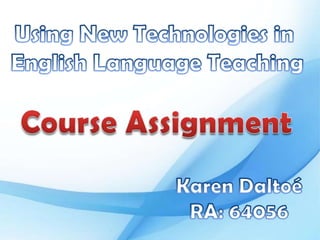
Assessment on Use of Technologies
- 2. I have a private intermediate student who I teach once a week (during lunch time) at his office. He is from Argentina and due to his accent he can’t pronounce some sounds (/v/,/r/). Words like very, valuable, rope are extremely difficult for him to speak. Also, I discovered that he used to stutter when he was younger (he doesn’t have a clue I know it), and the solution for that was thinking a lot before saying anything, damaging his speaking and listening skills, once he’s not prompt to answer. We have been working together for two months and all he wants is to learn English, without any specific purposes. During this time my objective was getting to know him, checking his grammar comprehension, testing his abilities.
- 3. I teach him in his own office. It is good in terms of noise – it is quiet, since his coworkers are at lunch during class time – and he has a computer and an IPad we can use. There is only one disadvantage about the equipment: I can’t use his computer once he needs to let it on in case someone (his boss) needs him. But there is free access to Internet and I can take my personal computer to classes, whenever I want.
- 4. Last meeting we worked with the simple past tense of verbs. As a final activity, I asked him to write a story according to some pictures we had. He worked really well with verbs, but we had to work together for linking the situations of the story (repetition of words, linkers, adverbs…). After that, I asked him to read the text out loud. It was a huge task for him and I could notice that even the words he usually says correctly were mispronounced while reading. Because of that, I asked him to write another text as homework which he is supposed to read to me in our next meeting. We worked for a long time on pronunciation and because of that, I decided to change the approach for the next classes, adding the usage of technology, increasing his time of English practice .
- 6. After our last meeting, I realized that this student needs: • to listen to himself in order to correct himself and/or understand my corrections; • to listen to English spoken by native people, so that he can memorize and practice the sounds of the English language; • to read sentences/texts out loud; • to practice writing in order to improve this skill, learning new structures.
- 7. We haven’t used any technology in classes so far. But now it is essential to include it, so that I can help him achieve another level in the language. Also, the technology will play an important role in the learning process since there are no other students in class. The technologies/media to be used are: - Computer - Voice recorder - YouTube - Email - Facebook
- 8. From now on, every class will have the following structure (not always the same order): 1) We will work with videos (songs, series, parts of movies, some humor, commercials…) from , focusing the aimed grammar point for that class. This will help him notice/practice the English language spoken by native speakers, the sounds of language, with a different range of activities for Listening (i.e.: filling the blanks) and Speaking (i.e.: repeating the words he hears).
- 9. 2) He will write a text every week (as homework) according to what will be asked: a diary, an answer to a question, his opinion about a specific subject, the summary of a book, movie… He must send it to me by . I will correct it, send him my impressions/corrections, print it, and we will work on it the next class – he will read his texts to me. This way I will promote more time for studying at home, for thinking in English, and also getting more material to explore his speaking and reading skills.
- 10. 3) We will work with the text he will have written at home (if he doesn’t, I’ll be prepared with another text). He’s going to read it out loud and I will record it ( ). Then, he will listen to himself, trying to identify mistakes/errors , and we will practice sounds. I think this will be the most effective source since he needs to “visualize” the problem. He needs to listen to himself in order to understand/compare what he is doing/saying from what must be done/said. Since he will have written the text, he will be familiarized with it, and will be able to pay attention only to pronunciation and intonation.
- 11. 4) Outside the classroom, we will be also connected by . This tool will help us maintain class work by sharing extra materials for practice: websites, Tongue Twisters (they’ will be of great importance), songs, chats… This way, I extend timing for practice, help creating a mood of expectation to classes in addition to being closer to the student, helping him on the spot, without having to wait so long.
- 12. It’s my first experience teaching English to a native Spanish speaker and I do expect that these tools help improve his language skills, specially speaking. I only have an hour class per week – this is not enough to help him effectively. Also, all technology, especially the internet, is well known for approximating people, for facilitating people’s lives, for giving access to knowledge. He is a great student, likes English a lot and loves having homework. This way, I believe the new approach will work perfectly, given he has a great appreciation for technology and he is used to working with it.
